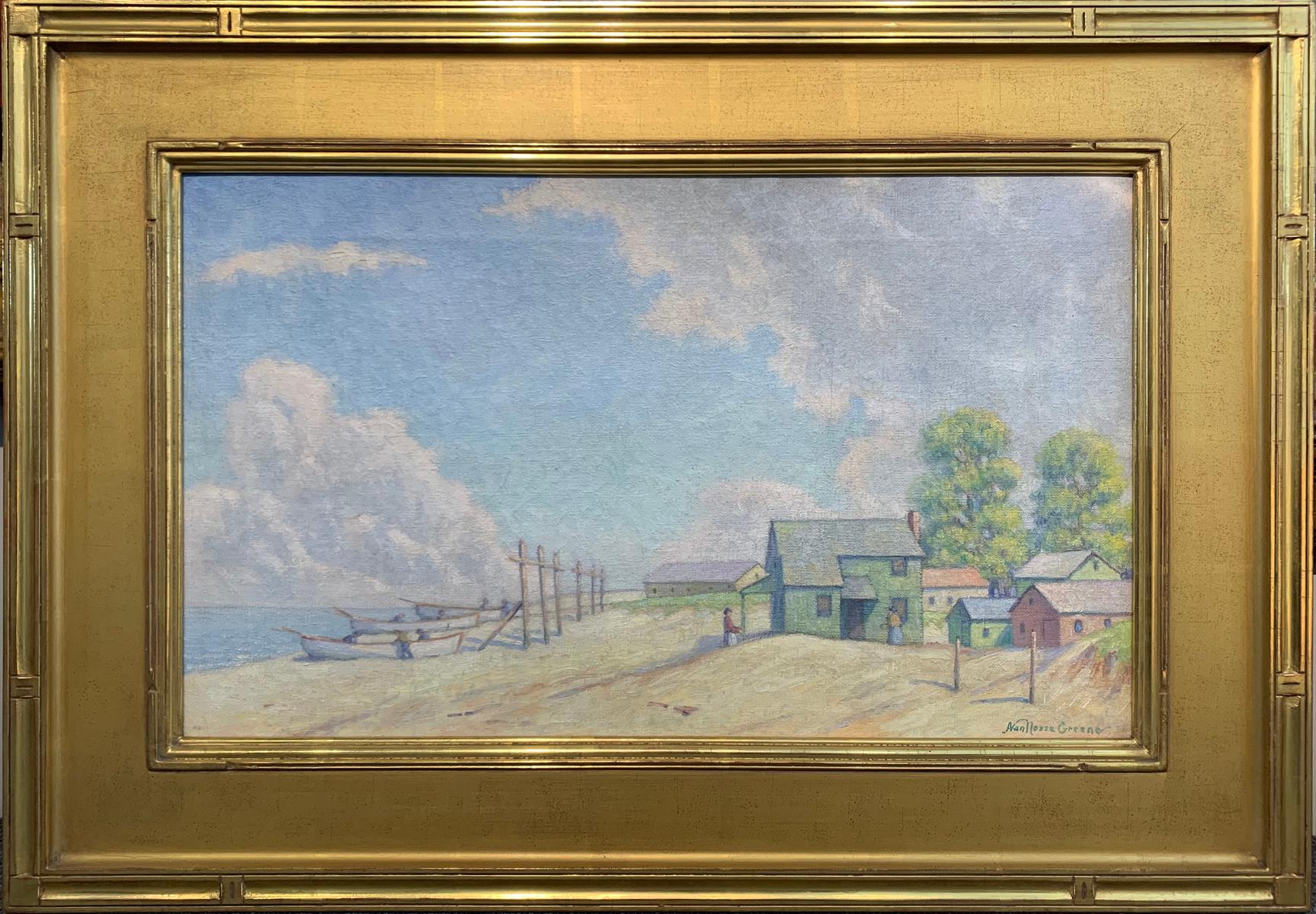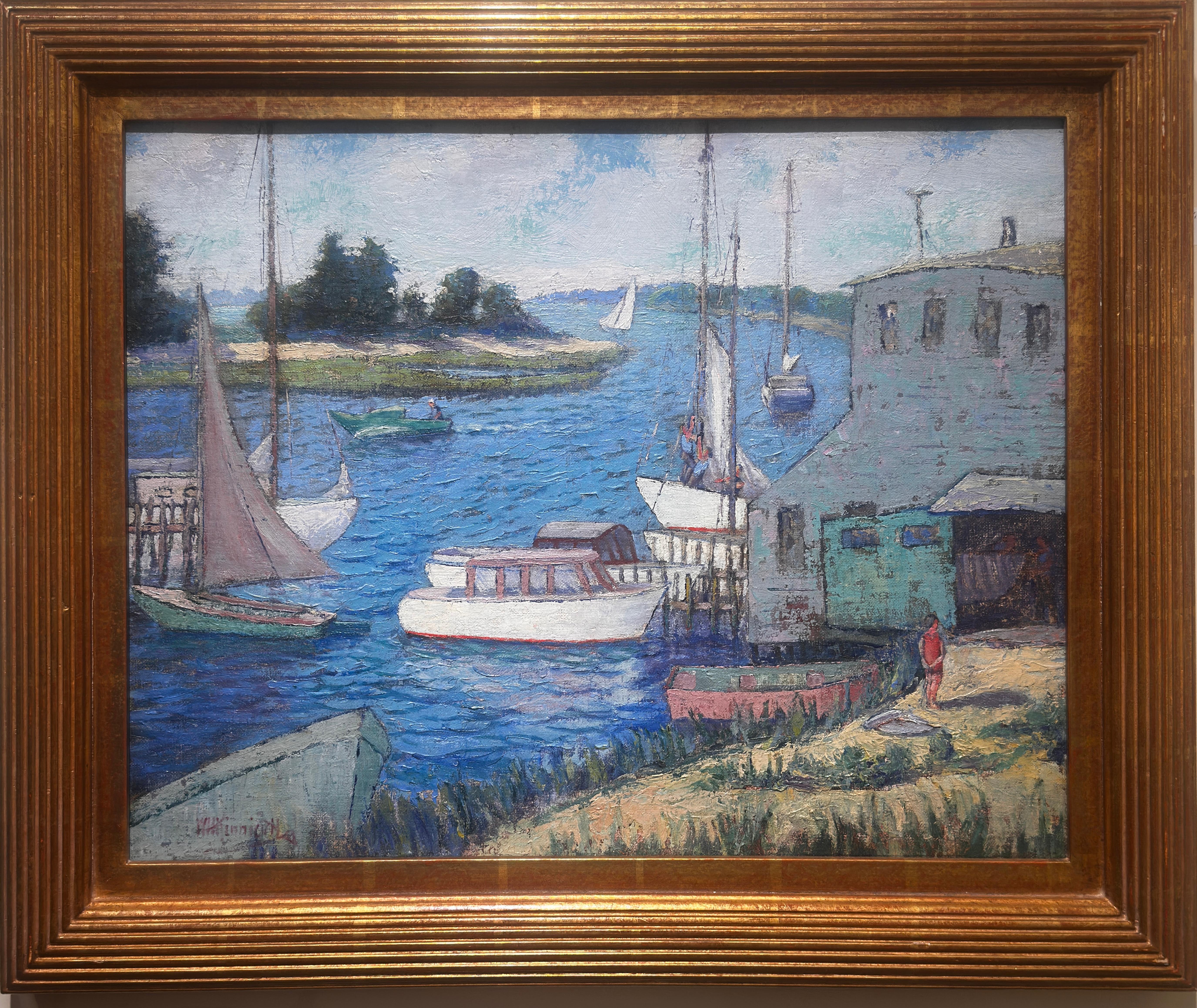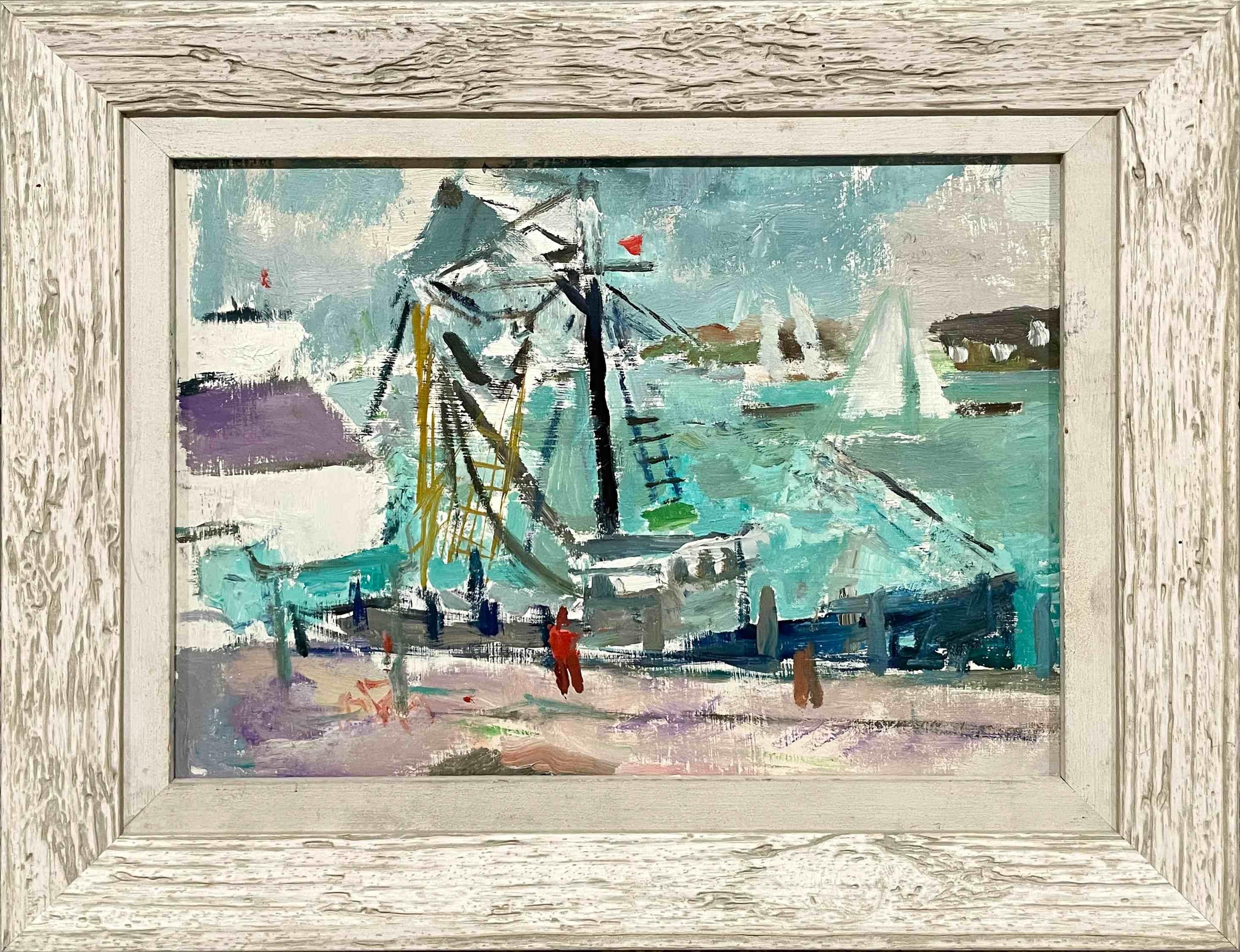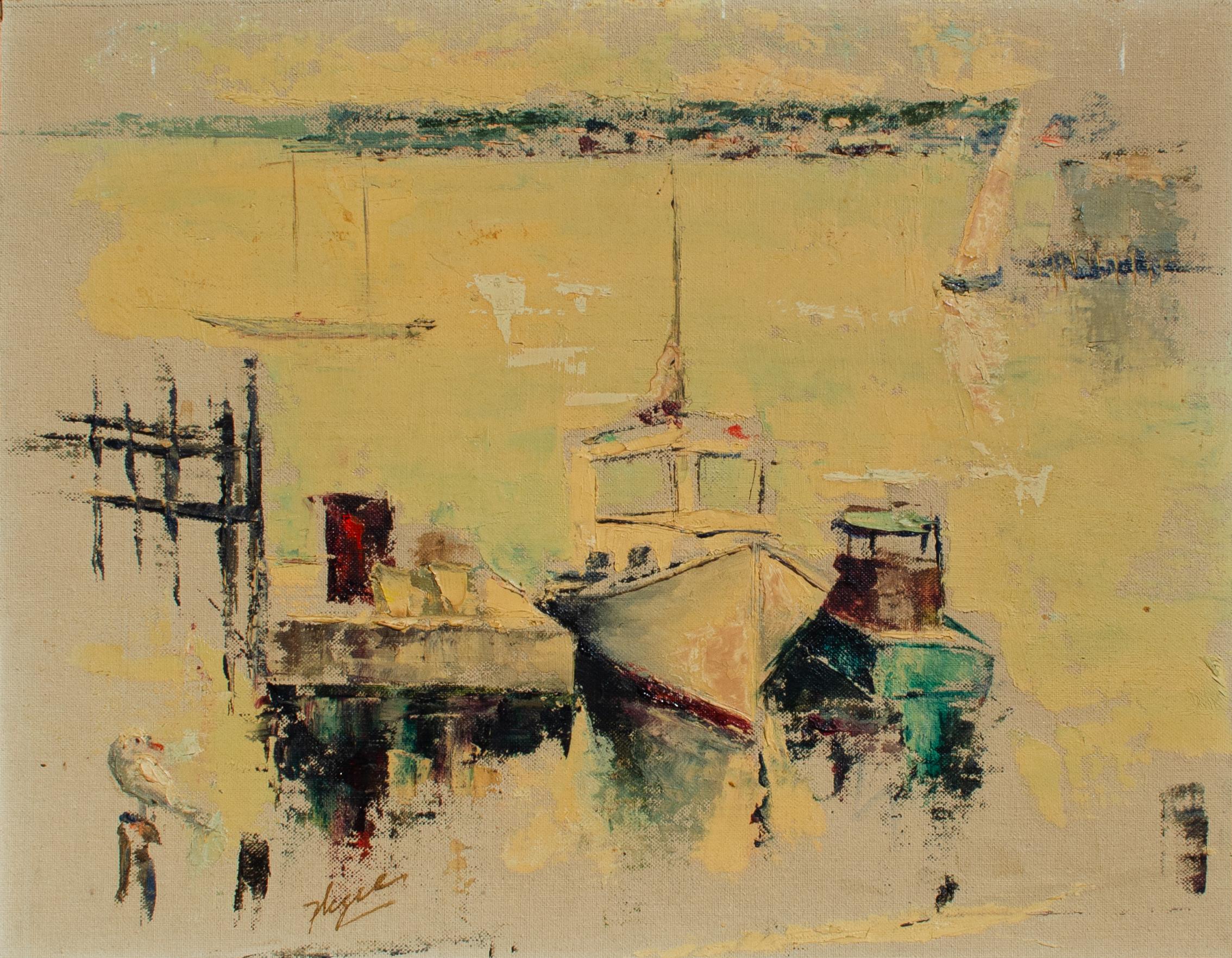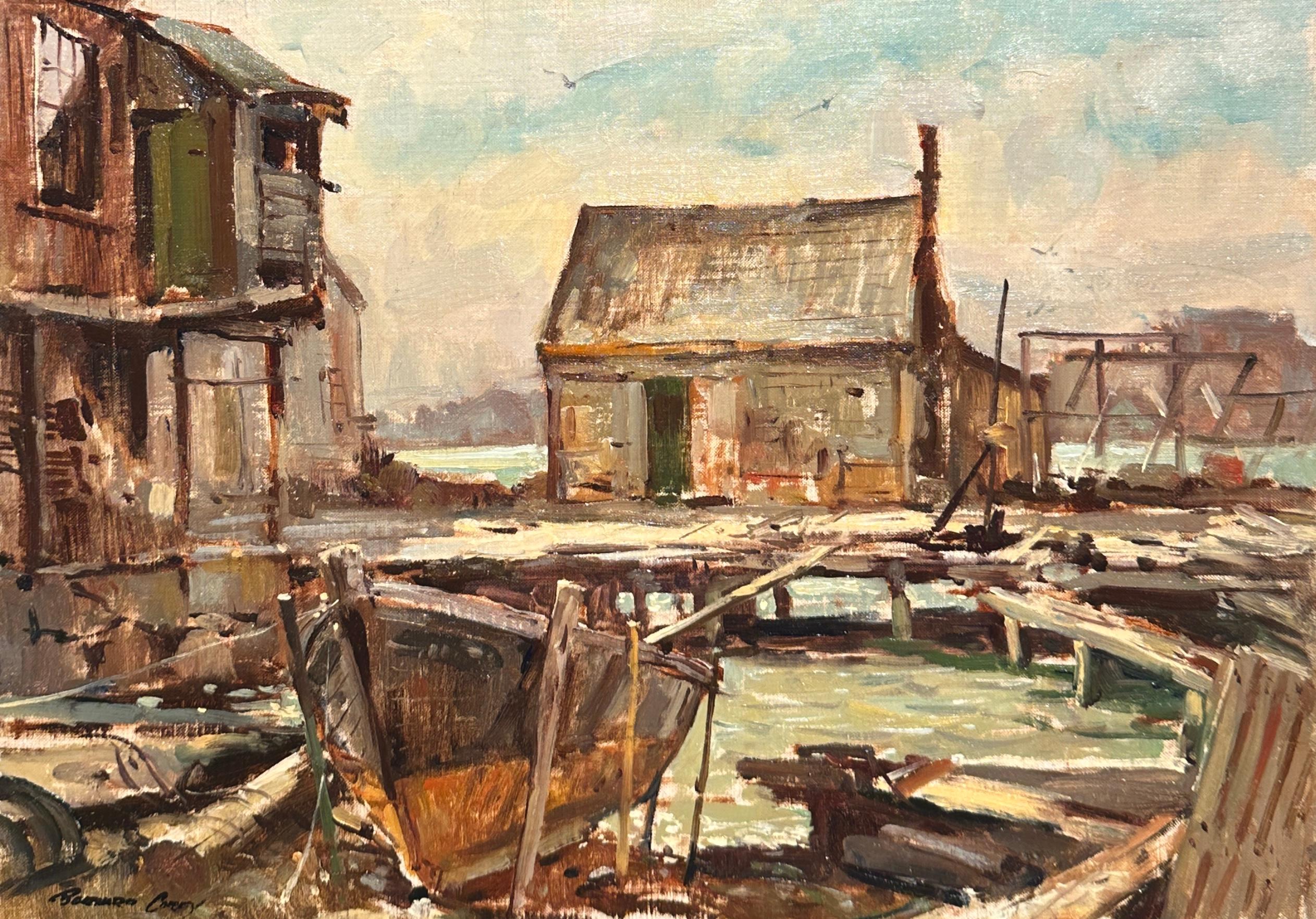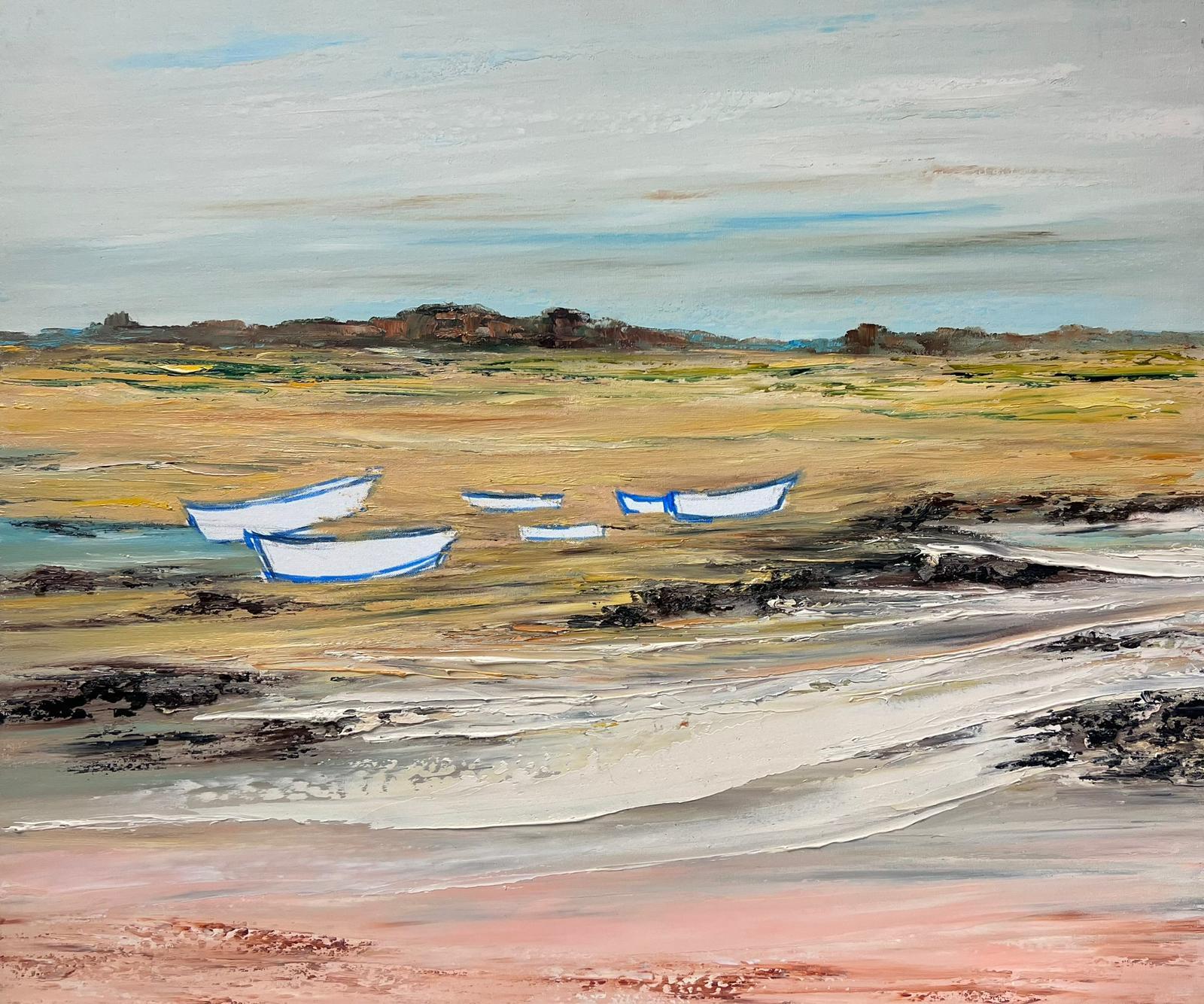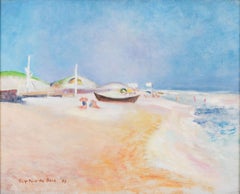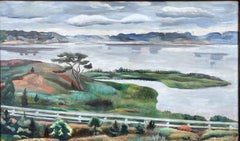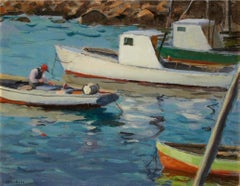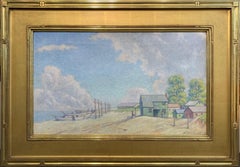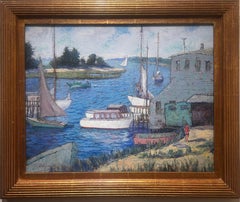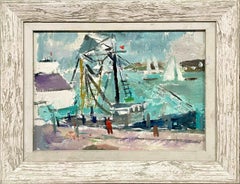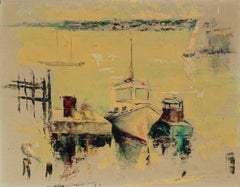Items Similar to "Low Tide at Noon, Wellfleet, Massachusetts, " Ernest Fiene, WPA, Boat on Beach
Want more images or videos?
Request additional images or videos from the seller
1 of 8
Ernest Fiene"Low Tide at Noon, Wellfleet, Massachusetts, " Ernest Fiene, WPA, Boat on Beach
$12,000
£9,026.88
€10,457.22
CA$16,917.52
A$18,813.41
CHF 9,872.70
MX$229,420.44
NOK 124,794.39
SEK 116,999.71
DKK 78,051.42
About the Item
Ernest Fiene (1894 - 1965)
Low Tide at Noon, Wellfleet, Massachusetts
Oil on canvas
26 x 36 inches
Signed lower right
Ernest Fiene was born in Elberfeld, Germany in 1894. As a teenager, Fiene immigrated to the United States in 1912. He studied art at the National Academy of Design in New York City from 1914 to 1918, taking day classes with Thomas Maynard and evening classes with Leon Kroll. Fiene continued his studies at the Beaux-Arts Institute of Design in Paris from 1916 to 1918, adding classes in printmaking at the Art Students League in 1923.
Fiene began his career as an artist in 1919 with his first exhibition of watercolors at the MacDowell Club arranged by his mentor Robert Henri. In 1923 the Whitney Studio Club mounted a large exhibition of his works. The following year he had an exhibition at the New Gallery in New York, which completely sold out all fifty-two works, including paintings, watercolors, drawings, and etchings. With the proceeds of sales from the New Gallery exhibition, Ernest Fiene and his younger brother Paul, a sculptor, built studios in Woodstock, New York in 1925.
In the early Twenties Ernest Fiene painted mostly landscapes of Woodstock and both the Ramapo and Hudson River Valleys. He was the subject of the first monograph for the Younger Artists Series in 1922. Published in Woodstock, the series went on to include Alexander Brook, Peggy Bacon, and Yasuo Kuniyoshi. The book reproduced 1 illustration in color and another 27 reproductions in black and white. Around 1925 Fiene became fascinated with the intensity, excitement, and opportunities for color harmonies New York City offered as a subject. His paintings shifted to urban and industrial themes with architecture, industry, and transportation becoming his subjects.
By 1926 Fiene had attracted the dealer Frank K.M. Rehn, who gave him a one-man exhibition that year, which travelled to the Boston Arts Club. C.W. Kraushaar Galleries gave Fiene a one-man exhibition of urban, landscape, portrait, and still life paintings in 1927. Julianna Force, the director of the Whitney Studio Club and first director of the Whitney Museum of American Art, included two of Fiene's paintings in a fall exhibition in 1928. The Whitney Studio Club showed Fiene's paintings in a two-man exhibition with Glenn O. Coleman that year and acquired three of Fiene's paintings. Also in 1928 Fiene became affiliated with Edith Halpert's Downtown Gallery where he had an exhibition of 20 lithographs in the spring. Fiene sold his house in Woodstock in 1928 to spend more of his time in New York City.
With so many successful exhibitions, Fiene returned to Paris in 1928-29 where he rented Jules Pascin's studio and studied at the Académie de la Grande Chaumière. In France, Fiene painted both landscape and urban subjects developed from ideas influenced by Cubist geometry and the use of flat areas of broad color. Upon returning to New York in 1930, Fiene used this new approach to continue to paint New York skyscraper and waterfront subjects, as well as to begin a series of paintings on changing old New York based on the excavations for Radio City Music Hall and the construction of the Empire State Building. Frank K.M. Rehn Galleries exhibited this series, titled "Changing Old New York," in 1931. Fiene also has solo exhibitions at Rehn Galleries in 1930 and 1932. Fiene's oil paintings are exhibited at the Chicago Arts Club in 1930 as well.
Fiene was included in the Museum of Modern Art's exhibition Painting and Sculpture by Living Americans in December of 1931. Visiting New York, Henri Matisse saw the exhibition and called Fiene's Razing Buildings, West 49th Street the finest painting he had seen in New York. Fiene had two mural studies from his Mechanical Progress series exhibited at the Museum of Modern Art's exhibition Murals by American Painters and Photographers in 1932. Fiene sent View from my Window which depicts Fiene working on a lithograph stone while looking out his window to the newly completed Empire State Building to the Carnegie International in 1931. In 1932 Fiene participated in the first Biennial of American Painting at the Whitney Museum and his prints were included in exhibitions at the Downtown Gallery and the Wehye Gallery. In the same year, Fiene was awarded a Guggenheim fellowship to further study mural painting in Florence, Italy.
On his return from Italy in 1933 Fiene re-engaged himself in New York City life and won several public and private mural projects. Fiene resumed his active exhibition schedule, participating in two group exhibitions at the Whitney Museum and a one-man exhibition of recent paintings at the Downtown Gallery in January 1934. In 1933 he purchased a farm in Southbury, Connecticut, which added Connecticut scenes to his landscape subjects. This was also the year Fiene began to spend summers on Monhegan Island, Maine, where he painted seascapes, harbor scenes, and still lifes.
Fiene's landscape paintings attracted numerous commissions as part of the American Scene movement. From 1935-36 Fiene took an extended sketching trip through the urban, industrial, and farming areas of Pennsylvania and West Virginia. Most of the twenty-four Pennsylvania urban and rural paintings from this trip were featured in an exhibition held at the First National Bank in Pittsburgh in October of 1937 by the Pittsburgh Commission for Industrial Expansion. Fiene said of these works that he formed rhythm, opportunity for space and color, and integrity in the Pennsylvania mill and furnace paintings. Fiene received the silver medal for one of the Pittsburgh paintings titled Frosty Morning at the Art Institute of Chicago in 1937.
The Colorado Springs Fine Arts Center invited Fiene to spend the summer of 1935 teaching there. He accepted and fit in painting trips through Colorado and New Mexico, including Taos and Santa Fe. In 1935, the Arts Center had an exhibition of his oils and watercolors. In August of that year the Denver Art Musuem has an exhibition of thirty paintings and watercolors and purchased the painting Connecticut Hills, Winter. The Denver Art Museum held an exhibition of Fiene's lithographs in 1937.
In 1937 Fiene also completed a mural for the Post Office in Canton, Massachusetts. In 1938 he completed a large four panel mural for the Department of the Interior Building in Washington, DC. Fiene's largest mural project was for the High School of Needle Trades, begun in 1937 and unveiled in 1940 after two and a half years of constant work.
Fiene had his largest exhibitions in 1940 with a total of 53 paintings and watercolors at his new dealer Associated American Artists. The exhibition includes Razing the Old Post Office, a New York subject which received a prize at the Carnegie International in 1939; Frosty Morning which received silver medal at the Art Institute of Chicago in 1937, and Spring Evening which received the W.A. Clark prize from the Corcoran Gallery in 1939.
Ernest Fiene participated in the American Tobacco Company's series of tobacco paintings, commissioned from 1940 to 1942 by the company's president George Washington Hill. American Tobacco sought the best artists of the time, including Ernest Fiene, Aaron Bohrod, Thomas Hart Benton, Doris Lee, George Schreiber and Frederick Taubes, to depict the entire tobacco production, from planting and harvesting to curing and auction. The paintings, which continued to arrive at American Tobacco until 1945, were used to decorate the company's headquarters and in advertisements. American Tobacco described the commission as "a series of paintings of the tobacco country by America's foremost artists."
During the war years, much of Fiene's commission work consisted of painting various phases of industry in relation to the war, such as the trips he took to Texas and Louisiana to record the operations of the oil industry. He also recorded the making of optical instruments at Abbott Laboratories in Corning, New York. These war industry paintings were exhibited in 1944 at the Associated American Artists gallery in New York City.
As a successful artist Fiene was in demand as a teacher. Fiene taught at Westchester County Center in New York from 1930 to 1931 and at the Cooper Union in New York from 1938 to 1939. At the Art Students League he taught a well-known Saturday class from 1939 until his death in 1965. Fiene also taught at the National Academy of Design from 1959 to 1964; he was elected an Academician there in 1952.
Fiene's dealer during the 1950s and 1960s was Midtown Galleries in New York. In 1959 Midtown gave Fiene a solo exhibition of his most recent, more abstracted New York City subjects, which received glowing reviews. Fiene enjoyed widespread respect among the community of artists in America. Elected president of the Artists Equity Association in 1953, Fiene remained that organization's president in an honorary capacity until his death in 1965. He maintained a long time personal correspondence with the artists George Grosz, Jules Pascin, Gaston Lachaise, Stuart Davis, and Thomas Hart Benton.
Ernest Fiene's work is included in numerous public collections, including the Brooklyn Museum, Art Institute of Chicago, Cleveland Museum of Art, Denver Art Museum, Los Angeles County Museum of Art, Museum of Fine Arts, Boston, Pennsylvania Academy of the Fine Arts, and the Whitney Museum of American Art.
- Creator:Ernest Fiene (1894-1965, American)
- Dimensions:Height: 30 in (76.2 cm)Width: 40 in (101.6 cm)
- Medium:
- Movement & Style:
- Period:
- Condition:
- Gallery Location:New York, NY
- Reference Number:1stDibs: LU1841210652842
About the Seller
5.0
Platinum Seller
Premium sellers with a 4.7+ rating and 24-hour response times
Established in 2022
1stDibs seller since 2022
118 sales on 1stDibs
Typical response time: <1 hour
- ShippingRetrieving quote...Shipping from: New York, NY
- Return Policy
Authenticity Guarantee
In the unlikely event there’s an issue with an item’s authenticity, contact us within 1 year for a full refund. DetailsMoney-Back Guarantee
If your item is not as described, is damaged in transit, or does not arrive, contact us within 7 days for a full refund. Details24-Hour Cancellation
You have a 24-hour grace period in which to reconsider your purchase, with no questions asked.Vetted Professional Sellers
Our world-class sellers must adhere to strict standards for service and quality, maintaining the integrity of our listings.Price-Match Guarantee
If you find that a seller listed the same item for a lower price elsewhere, we’ll match it.Trusted Global Delivery
Our best-in-class carrier network provides specialized shipping options worldwide, including custom delivery.More From This Seller
View All"Seaside (Amagansett Beach)" Guy Pène du Bois, American Realist Beach Scene
By Guy Pène Du Bois
Located in New York, NY
Guy Pene du Bois
Seaside (Amagansett Beach), 1939
Signed and dated lower left; artist label on the reverse: "Seaside CAT No 192"
Oil on canvas
16 x 20 inches
Pène du Bois descended...
Category
1930s Realist Figurative Paintings
Materials
Oil, Canvas
"Wellfleet, Cape Cod, " Gerrit Beneker, American Impressionism, Provincetown
By Gerrit Beneker
Located in New York, NY
Gerrit Beneker (1882 - 1934)
Wellfleet, Cape Cod, Massachusetts, New England, 1926
Oil on canvas
20 x 16 inches
Signed, titled, and dated lower left
Provenance:
Louis H. Barnett, Fort Worth, Texas
In 1905, Gerrit Beneker began his art career as an illustrator. He married Flora Judd, his high school sweetheart from Grand Rapids and they moved to Brooklyn, NY. Gerrit's early passion was to create an art that would inspire and provide honor to the workingman. As such, he had no interest in painting portraits of pretty women, which were so often seen on the magazine covers of the day. Rather he wanted to seek out workingmen on the bridges, tunnels and skyscrapers of NYC, and paint them in their environments. He completed over 150 magazine covers, numerous ads including many for Ivory Soap...
Category
1920s American Impressionist Landscape Paintings
Materials
Canvas, Oil
"Buttermilk Bay, Cape Cod, " Georgina Klitgaard, Woodstock School Female WPA
By Georgina Klitgaard
Located in New York, NY
Georgina Klitgaard (1893 - 1976)
Buttermilk Bay, Cape Cod, Massachusetts, 1933
Oil on canvas
18 x 30 inches
Signed lower right
Provenance:
Frank K. M. Rehn Galleries, New York
Harold Ordway Rugg
Private Collection, Western New York
Georgina Berrian was born in Spuyten Duyvil, New York in 1893. She was educated at Barnard College...
Category
1930s American Modern Landscape Paintings
Materials
Canvas, Oil
"Fisherman of Yankee Cove, " Harry Leith-Ross, Boat Landscape
By Harry Leith-Ross
Located in New York, NY
Harry Leith-Ross (1886 - 1973)
Fisherman of Yankee Cove
Oil on canvasboard
8 1/8 x 10 1/2 inches
Signed lower left; also with artist, title, and number '39' on label verso
Provenance:
Private Collection, Pennsylvania
Landscape painter Harry Leith-Ross was born in Mauritius in 1886, a British possession in the Indian Ocean. He came to America as a seventeen year old. Before beginning, some ten years later in 1914, his studies at the Art Students League Summer School in Woodstock, New York at the relatively late age of twenty-eight, Leith-Ross had worked as a commercial artist. He studied with John F. Carlson and Birge Harrison at the League Summer School, and later with C. Y. Turner at the National Academy of Design in New York City. He then went to Paris, studying with Jean Paul Laurens at the Academie Julien and in England with Stanhope Forbes.
Long associated with the Bucks County artists' colony in New Hope, Pennsylvania, Leith-Ross may have first gone there in 1912. It is definitely known that he visited the area in 1916 at the invitation of a student he had met when both attended the Art Students League Summer School in Woodstock, John Fulton Folinsbee. Birge Harrison, his former instructor at the League, whom he met again, was also there in New Hope during the winters from 1914 to 1916. The third and last generation of the New Hope colony would be comprised of artists like Leith-Ross, Folinsbee and Kenneth R. Nunamaker.
It is somewhat ironic that Leith-Ross, so long affiliated with the New Hope School of American Impressionism...
Category
Mid-20th Century American Impressionist Landscape Paintings
Materials
Oil, Board
"Lobstermen in Gloucester, Mass." Lionel Reiss WPA Social Realism Fishermen
By Lionel S. Reiss
Located in New York, NY
Lionel S. Reiss (1894 - 1988)
Lobstermen in Gloucester, Massachusetts, circa 1943
Watercolor on paper
Sight 17 1/2 x 23 inches
Signed lower left
Provenance:
Private Collection, Las Vegas, Nevada
In describing his own style, Lionel Reiss wrote, “By nature, inclination, and training, I have long since recognized the fact that...I belong to the category of those who can only gladly affirm the reality of the world I live in.” Reiss’s subject matter was wide-ranging, including gritty New York scenes, landscapes of bucolic Bucks County, Pennsylvania, and seascapes around Gloucester, Massachusetts. However, it was as a painter of Jewish life—both in Israel and in Europe before World War II—that Reiss excelled. I.B. Singer, the Nobel Prize winner for Literature, noted that Reiss was “essentially an artist of the nineteenth century, and because of this he had the power and the courage to tell visually the story of a people.”
Although Reiss was born in Jaroslaw, Poland, his family immigrated to the United States in 1898 when he was four years old. Reiss's family settled on New York City’s Lower East Side and he lived in the city for most of his life. Reiss attended the Art Students League and then worked as a commercial artist for newspapers and publishers. As art director for Metro-Goldwyn-Mayer, he supposedly created the studio’s famous lion logo.
After World War I, Reiss became fascinated with Jewish life in the ‘Old World.’ In 1921 he left his advertising work and spent the next ten years traveling in Europe, the Middle East, and North Africa. Like noted Jewish photographers Alter Kacyzne and Roman Vishniac, Reiss depicted Jewish life in Poland prior to World War II. He later wrote, “My trip encompassed three main objectives: to make ethnic studies of Jewish types wherever I traveled; to paint and draw Jewish life, as I saw it and felt it, in all aspects; and to round out my work in Israel.”
In Europe, Reiss recorded quotidian scenes in a variety of media and different settings such as Paris, Amsterdam, the Venice ghetto, the Jewish cemetery in Prague, and an array of shops, synagogues, streets, and marketplaces in the Jewish quarters of Warsaw, Lodz, Krakow, Lublin, Vilna, Ternopil, and Kovno. He paid great attention to details of dress, hair, and facial features, and his work became noted for its descriptive quality.
A selection of Reiss’s portraits appeared in 1938 in his book My Models Were Jews. In this book, published on the eve of the Holocaust, Reiss argued that there was “no such thing as a ‘Jewish race’.” Instead, he claimed that the Jewish people were a cultural group with a great deal of diversity within and between Jewish communities around the world. Franz Boas...
Category
1940s American Realist Landscape Paintings
Materials
Paper, Watercolor
"Nantucket, Massachusetts" Helen Goodwin, American Impressionism Docks at Harbor
Located in New York, NY
Helen M. Goodwin (1865 - 1955)
Nantucket, Massachusetts
Oil on canvas laid on panel
12 x 16 inches
Signed and titled lower right
Helen M. Goodwin was born in New Castle, Indiana in ...
Category
Early 20th Century American Impressionist Landscape Paintings
Materials
Oil, Panel, Canvas
You May Also Like
Figures, Boats, and House - Cape May Point, NJ, Impressionist Beach Scene, 1940s
By Albert Van Nesse Greene
Located in Doylestown, PA
"Figures, Boats, and House - Cape May Point, NJ" is a Pennsylvania Beach Scene by American Impressionist painter Albert Van Nesse Greene.
The ...
Category
1940s American Impressionist Landscape Paintings
Materials
Oil, Canvas
Crosby’s Boat Yard, Cape Cod
Located in Spokane, WA
Titled on verso panel
Signed lower left corner
Measures
Painting 17 x 22 inches
Framed 21.125 x 26.75 inches
William H. Kinnicutt (1865–1934) was an American artist known for his ...
Category
Early 20th Century American Impressionist Landscape Paintings
Materials
Oil, Panel
$10,000 Sale Price
20% Off
A Charming 1950s Mid-Century Modern Harbor Scene of Martha's Vineyard
By Francis Chapin
Located in Chicago, IL
A Charming 1950s Mid-Century Modern Harbor Scene of Martha's Vineyard by Notable Chicago Artist, Francis Chapin (Am. 1899-1965). Completed near the artist's studio and summer home in the historic whaling port town of Edgartown, Massachusetts; a cheerful, diminutive painting of a busy sunlit boat dock. Artwork size: 8 3/4" x 11 3/4". Framed size: 12 1/2" x 15 1/2". Estate stepped on reverse. Provenance: Estate of the artist.
Francis Chapin, affectionately called the “Dean of Chicago Painters” by his colleagues, was one of the city’s most popular and celebrated painters in his day. Born at the dawn of the 20th Century in Bristolville, Ohio, Chapin graduated from Washington & Jefferson College near Pittsburgh, Pennsylvania before enrolling at the Art Institute of Chicago in 1922. He would set down deep roots at the Art Institute of Chicago, exhibiting there over 31 times between 1926 and 1951. In 1927 Chapin won the prestigious Bryan Lathrop Fellowship from the Art Institute – a prize that funded the artist’s yearlong study trip to Europe. Upon his return to the United States, Chapin decided to remain in Chicago, noting the freedom Chicago artists have in developing independently of the pressure to conform to pre-existing molds (as was experienced by artists in New York, for example). Chapin became a popular instructor at the Art Institute, teaching there from 1929 to 1947 and at the Art Institute’s summer art school in Saugatuck, Michigan (now called Oxbow) between 1934 – 1938 (he was the director of the school from 1941-1945).
A prolific painter, Chapin produced numerous works while traveling in Mexico, France, Spain, Saugatuck and Martha’s Vineyard, where he frequently spent summers and taught at the Old Sculpin Gallery there. Chapin was best recognized for his dynamic and vibrant images of Chicago during the 1930s and 40s. Chapin was a resident of the Old Town neighborhood where he lived and kept his studio on Menomonee Street for many years. Described as a “colorful figure, nearly 6 feet 6 inches tall, and thin, and usually wearing tweeds”, it is easy to imagine Chapin at work observing the busy street life of the city.
In addition to his many exhibitions at the Art Institute of Chicago, Chapin’s work was shown during his lifetime at such institutions as the Pennsylvania Academy of Fine Arts, Philadelphia; the Corcoran Gallery, Washington, D.C.; the National Academy of Design, New York; the Museum of Modern Art, New York; the Whitney Museum of American Art, New York and the Carnegie Institute, Pittsburgh, among others. Francis Chapin’s paintings are represented in the collections the Art Institute of Chicago; the Friedman Collection, Chicago; the Butler Institute of American Art, Youngstown; the Denver Art Museum; the Everson Museum of Art, Syracuse; the Norton Museum of Art, West Palm Beach...
Category
Mid-20th Century American Modern Landscape Paintings
Materials
Masonite, Oil
Docked Fishing Boat in Gloucester, MA, by Mystery American Artist
Located in New York, NY
Mystery American Artist
No. 9 Glouchester, c. Early 20th Century
Oil on artist board
16 x 20 in.
Framed: 20 x 24 x 1 1/2 in.
Signed lower left
Inscribed verso: Dolitsky / No 9 Glouch...
Category
Early 20th Century American Impressionist Figurative Paintings
Materials
Oil, Board
New England Harbor Dock Scene with Boat by Bernard Corey
By Bernard Corey
Located in Rockport, MA
In Dock Scene, American artist Bernard Corey captures the quiet beauty of a New England harbor. Corey's loose, expressive brushwork and earthy tones reflect the hallmarks of American...
Category
20th Century American Impressionist Landscape Paintings
Materials
Oil
20th Century French Modernist Signed Oil Boats Moored on Beach
Located in Cirencester, Gloucestershire
Beached Boats
by Lucien Gondret (French b. 1941)
signed oil painting on canvas, unframed
canvas: 18.5 x 22 inches
provenance: private collection, France
condition: very good and soun...
Category
Late 20th Century Modern Landscape Paintings
Materials
Oil
More Ways To Browse
Boats On The Beach
Boats On A Beach
Artist Painting Landscape Wpa
Wpa Lithograph
Low Country Art
Low Country Painting
Mexican Boat Paintings
Coopers Beach
Wpa Mural Study
Wpa Still Life
Thomas Hill Oil Painting
Paris Street Scene Painting Large Canvas Painting
Taos Moderns Paintings
Oil Paintings Signed By Stuart
Maine Seascape Paintings
Empire State Building Painting
Framed Wpa Prints
Pascin Jules
